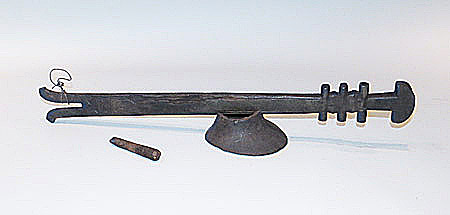
Owner: HWMC
Catalog#: AF-CHZT-12-14
Provenance: Africa Direct
Zithers
Malagasy 'Lokanga Voatavo' (B)
Madagascar
Malagasy
Gourd, wood, metal wire
Early 20th century
Length: 21 inches
Chordophone – Zither-stick-plucked
Please check the larger ‘lokanga’ (‘herrauou’), example (A) in this collection. In Madagascar, the zither has two names, ‘lokanga voatavo’ or ‘herrauou’ (gourd instrument) and ‘dzedzy’ or ‘jejy’ in Swahili, a word that appears to date back to the name of an ancient Egyptian harp, the ‘dede.’ In the western part of Madagascar, a corruption of the name, ‘dzédzivoatavo,’ can even be found. It is widespread throughout Madagascar with the exception of the northern region of the island.
The ‘lokanga’ (‘herrauou’) sound box may take several shapes, made either from a gourd as seen here, or quite simply from an oil can. It was first played by the nobility and then abandoned to slaves musicians. Today, zither players are still called ‘mpilalao.’
This ‘lokanga’ (‘herrauou’) is a stand-alone plucked stringed instrument. This one is made of three metal wires that produces a louder sound than the fiber strings, are fitted along a strip of wood that acts as a handle. The small single gourd that serves as a resonator is pressed against the chest. The neck slants at a 40-degree angle with three deep projections for the first finger, middle finger and ring finger. The right hand, which supports the neck close to the gourd, plucks the string with the middle finger.
The lokanga voatavo is not used in ceremonies but only for choral speaking, stories, legends and satires. It is also used for entertainment at family celebrations and village festivals as well as to amuse small children in the evening around the fire before dinner.
Source: Staying in Tune: Chordophones | The Jeyji Voatavo by Noely, (virtualmuseum.ca)
